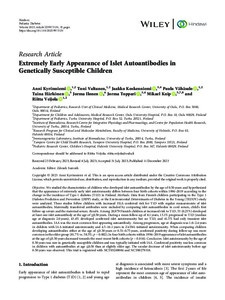Extremely Early Appearance of Islet Autoantibodies in Genetically Susceptible Children
Kyrönniemi Anni; Valtanen Toni; Koskenniemi Jaakko; Vähäsalo Paula; Härkönen Taina; Ilonen Jorma; Toppari Jorma; Knip Mikael; Veijola Riitta
https://urn.fi/URN:NBN:fi-fe2025082791415
Tiivistelmä
Objective. We studied the characteristics of children who developed islet autoantibodies by the age of 0.50 years and hypothesized that the appearance of extremely early islet autoimmunity differs between four birth cohorts within 1994–2019 according to the change in the incidence of Type 1 diabetes (T1D) in Finland. Methods. Data from Finnish children participating in the Type 1 Diabetes Prediction and Prevention (DIPP) study, or the Environmental Determinants of Diabetes in the Young (TEDDY) study were analyzed. These studies follow children with increased HLA-conferred risk for T1D with regular measurements of islet autoantibodies. Maternally transferred antibodies were excluded by comparing islet autoantibodies in cord serum, child’s first follow-up serum and the maternal serum. Results. Among 20,979 Finnish children at increased risk to T1D, 53 (0.25%) developed at least one islet autoantibody at the age of ≤0.50 years. During a mean follow-up of 8.1 years, 15.1% progressed to T1D (median age at diagnosis 2.0 years), 43.4% developed confirmed islet autoimmunity but no T1D, and 41.5% had only transient islet autoantibodies. IAA was the most common first-appearing autoantibody. Among progressors, age at diagnosis was 1.0–2.4 years in children with IAA-initiated autoimmunity and 4.5–16.1 years in ZnT8A-initiated autoimmunity. When comparing children developing autoantibodies either at the age of ≤0.50 years or 0.51–0.75 years, confirmed positivity during follow-up was more common in the older group (81.7% vs. 58.5%; ). In four birth cohorts within 1994–2019 appearance of islet autoantibodies at the age of ≤0.50 years decreased towards the most recent birth cohorts (). Conclusion. Islet autoimmunity by the age of 0.50 years was rare in genetically susceptible children and was typically initiated with IAA. Confirmed positivity was less common in children with autoantibodies at age ≤0.50 than at slightly older age. The secular decrease of islet autoimmunity before age 0.50 years was observed. This trial is registered with NCT03269084 and NCT00279318.
Kokoelmat
- Rinnakkaistallenteet [27094]
